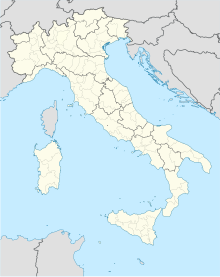Capri
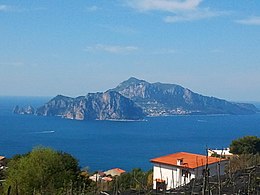 View fromTermini | |
| Geography | |
|---|---|
| Location | Tyrrhenian Sea |
| Coordinates | 40°33′00″N14°14′00″E/ 40.55000°N 14.23333°E |
| Area | 10.4 km2(4.0 sq mi) |
| Highest elevation | 589 m (1932 ft) |
| Highest point | Monte Solaro |
| Administration | |
Italy | |
| Region | Campania |
| Metropolitan City | Naples |
| Largest settlement | Capri(pop. 7,278) |
| Demographics | |
| Population | 12,903 (2022) |
| Pop. density | 1,170/km2(3030/sq mi) |

Capri(/ˈkæpri/KAP-ree,USalso/kəˈpriː,ˈkɑːpri/kə-PREE,KAH-pree;Italian:[ˈkaːpri];adjectiveCaprese) is an island located in theTyrrhenian Seaoff theSorrento Peninsula,on the south side of theGulf of Naplesin theCampaniaregion of Italy. The largest settlement on the island is the town ofCapri.The island has been aresortsince the time of theRoman Republic.
Some of the main features of the island include theMarina Piccola(the little marina), the Belvedere of Tragara (a high panoramic promenade lined with villas), the limestone crags called sea stacks that project above the sea (thefaraglioni), the town ofAnacapri,theBlue Grotto(Grotta Azzurra), the ruins of the Imperial Roman villas, and the vistas of various towns surrounding the Island of Capri includingPositano,Amalfi,Ravello,Sorrento,Nerano, andNaples.
Capri is part of the region ofCampania,Metropolitan City of Naples.The town ofCapriis acomuneand the island's main population centre. The island has two harbours,Marina PiccolaandMarina Grande(the main port of the island). The separatecomuneof Anacapri is located high on the hills to the west.
Etymology
[edit]The etymology of the name Capri is unclear. It might be traced back to theAncient Greekκάπροςkáprosmeaning 'wild boar',[1]as the Greeks ofMagna Graecia,who were the first recorded colonists to populate the island, called itKapreai(Καπρέαι).[2]It could also derive fromLatincapreae('goats').[1]Fossils of wild boars have been discovered, lending credence to thekáprosetymology.[citation needed]
Finally, there is also the possibility that the name derives from anEtruscanword for 'rocky', though any historical Etruscan rule of the island is disputed. Capri consists of limestone and sandstone rock; cliffs form much of the sides and surface of the island.[3]
Government
[edit]The voters of the island elect representatives for the two municipalities (comuni) on the island. The chosen representatives then choose two mayors to govern with them.[3]
History
[edit]Ancient and Roman times
[edit]
The island has been inhabited since early times. Evidence of human settlement was discovered during the Roman era; according toSuetonius,when the foundations for the villa ofAugustuswere being excavated, giant bones and 'weapons of stone' were discovered. The emperor ordered these to be displayed in the garden of his main residence, the Sea Palace.
at Capreae the monstrous bones of huge sea monsters and wild beasts, called the "bones of the giants," and the weapons of the heroes.[4]
Modern excavations have shown that human presence on the island can be dated to theNeolithicand theBronze Age.Augustus developed Capri; he built temples, villas, aqueducts, and planted gardens so he could enjoy his private paradise.[5]
In hisAeneid,Virgilstates that the island had been populated by the Greek people of Teleboi, coming from theIonian Islands.Strabo says that "in ancient times in Capri there were two towns, later reduced to one."[6]Tacitusrecords that there were twelve Imperial villas in Capri. Ruins of one at Tragara could still be seen in the 19th century.[citation needed]
Augustus' successorTiberiusbuilt a series of villas at Capri, the most famous of which is theVilla Jovis,one of the best-preserved Roman villas in Italy. In 27 AD, Tiberius permanently moved to Capri, running theEmpirefrom there until his death in 37 AD.[citation needed]
In 182 AD, EmperorCommodusbanished his sisterLucillato Capri. She was executed shortly afterwards.[citation needed]
Middle and Modern Ages
[edit]
After the end of theWestern Roman Empire,Capri returned to the status of a dominion ofNaples,and suffered various attacks and ravages by pirates. In 866 EmperorLouis IIgave the island toAmalfi.In 987Pope John XVconsecrated the first bishop of Capri, when Capri,Scala,Minori,andLetterewere made dioceses to serve assuffragansofAmalfi,which thereby became ametropolitan see.[7]Capri continued to be a residential diocese until 1818, when the island became part of thearchdiocese of Sorrento.[8]No longer a residential bishopric, Capri, Capreae inLatin,is today listed by theCatholic Churchas atitular see.[9]
In 1496,Frederick IV of Naplesestablished legal and administrative parity between the settlements of Capri and Anacapri. The pirate raids reached their peak during the reign ofCharles V:the famous Turkish admiralsBarbarossa Hayreddin PashaandTurgut Reiscaptured the island for the Ottoman Empire, in 1535 and 1553, respectively.[citation needed]
The first recordedtouristto visit the island was French antiques dealerJean-Jacques Bouchardin the 17th century. His diary, found in 1850, is an important information source about Capri.[citation needed]
1800s–present
[edit]
French troops underNapoleonoccupied Capri in January 1806. The British ousted the French in the following May, after which Capri was turned into a powerful naval base (a "SecondGibraltar"), but the building program caused heavy damage to the archaeological sites. The French reconquered Capri in 1808, and remained there until the end of the Napoleonic era (1815), when Capri was returned to the Bourbon ruling house of Naples.[citation needed]
Thenatural scientistIgnazio Ceriocatalogued Capri'sfloraandfaunaduring the 19th century. His work was continued by his son, author and engineerEdwin Cerio,who wrote several books on life in Capri in the 20th century.[citation needed]
Prior to the First World War the island was extremely popular with wealthy gay men.John Ellingham BrooksandSomerset Maughamshared a villa there.[10]Friedrich Alfred Krupp,the German industrialist, was accused of homosexual orgies[11]and eventually committed suicide.
Norman Douglas,Jacques d'Adelswärd-Fersen,Christian Wilhelm Allers,Emil von Behring,Curzio Malaparte,Axel Munthe,Louis CoatalenandMaxim Gorkyare all reported to have owned a villa there, or to have stayed there for more than three months. Swedish QueenVictoriaoften stayed there because Axel Munthe was her doctor.Rose O'Neill,the American illustrator and creator of theKewpie,owned the Villa Narcissus, formerly owned by the famous Beaux-Arts painterCharles Caryl Coleman.DameGracie Fieldsalso had a villa and restaurant on the island and is buried there.[citation needed]
In 1908,Leninwas hosted byMaxim Gorky,the Russian author, at his house near the Giardini Augusto. In 1970, a monument byGiacomo Manzùwas erected during the centennial celebration in Lenin's honour.[citation needed]
Capri, as with the Sicilian resort ofTaormina,became "high on the list of places to be visited by homosexual northerners", according toGregory Woods,chair in Gay and Lesbian Studies. Thehistory of Taorminawas changed by the presence ofWilhelm von Gloeden,known for his homoerotic photography, whose studio from 1878 to 1931 drew many visitors to the town. Both Capri and Taormina were tolerant of gay men and artists, and there was much interchange between the two places. In December 1897Oscar Wildewas planning to winter in Naples with his loverLord Alfred Douglas;the couple made a short visit to Capri, but their presence proved too scandalous for even that liberal island ( "They even denied us bread!" ), so "Bosie" headed back to England and Wilde made his way to Taormina, where he spent time with von Gloeden.[12]Jacques d'Adelswärd-Fersen, who settled in Capri and builtVilla Lysis,visited von Gloeden in 1923, bringing with him his schoolboy lover/secretary.[13]
Today, Capri has become more of a resort and is visited by tourists during the summer months of July and August.[14]Mariah Careyowns a villa on the island.[citation needed]
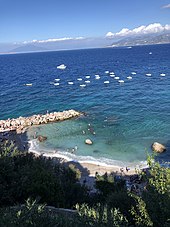
Cultural references
[edit]
During the later half of the 19th century, Capri became a popular resort for European artists, writers and other celebrities. The book that spawned the 19th century fascination with Capri in France, Germany, and England wasEntdeckung der blauen Grotte auf der Insel Capri('Discovery of the Blue Grotto on the Isle of Capri') by theGermanpainter and writerAugust Kopisch,in which he describes his 1826 stay on the island and his (re)discovery of theBlue Grotto.[citation needed]

John Singer SargentandFrank Hydeare among the prominent artists who stayed on the island around the late 1870s. Sargent is known for his series of portraits featuring local modelRosina Ferrara.The English artist and adventurer, John Wood Shortridge, acquired a fortino atMarina Piccolain the 1880s, (later transformed into a private villa by DameGracie Fields) and married a Capri girl, Carmela Esposito. He formed a close friendship with the English novelistGeorge Gissingwho provides a colourful and insightful account of his stays with Shortridge in hisPublished Letters of George Gissing.In the Gissing Journal, vol. XXXV, no. 3 (July, 1999), p. 2. it is recorded that the only mention of him in a recent book, albeit partially inaccurate, occurs in James Money'sCapri: Island of Pleasure(London: Hamish Hamilton, 1986, p. 42).Claude Debussyrefers to the island's hills in the title of his impressionisticpréludeLes collines d'Anacapri(1910). Capri is the setting for "The Lotus Eater"(1945), a short story bySomerset Maugham.In the story, the protagonist from Hendon, part of the borough of Barnet in London, comes to Capri on a holiday and is so enchanted by the place he gives up his job and decides to spend the rest of his life in leisure there. British novelistCompton Mackenzielived there from 1913 to 1920, with later visits, and set some of his work on the island (e.g.Vestal Fire,1927).[citation needed]
As well as being a haven for writers and artists, Capri served as a relatively safe place for foreign gay men and lesbians to lead a more open life; a small nucleus of them were attracted to live there, overlapping to some extent with the creative types mentioned above. PoetAugust von Platen-Hallermündewas one of the first.Jacques d'Adelswärd-Fersenwrote theroman à clefEt le feu s'éteignit sur la mer(1910) about Capri and its residents in the early 20th century, causing a minor scandal. Fersen's life on Capri became the subject ofRoger Peyrefitte's fictionalised biography,L'Exilé de Capri.A satirical presentation of the island's lesbian colony is made in Mackenzie's 1928 novelExtraordinary Women,inspired by the affairs of American painterRomaine Brooks(in the novel, under the pseudonym of Olimpia Leigh).[15]One of the island's most famous foreign gay exiles wasNorman Douglas;his novelSouth Wind(1917) is a thinly fictionalised description of Capri's residents and visitors, and a number of his other works, both books and pamphlets, deal with the island, includingCapri(1930) and his last work,Footnote on Capri(1952).[citation needed]
Memoirs set on Capri includeEdwin Cerio'sAria di Capri(1928) (translated asThat Capri Air), which contains a number of historical and biographical essays on the island, including a tribute to Norman Douglas;The Story of San Michele(1929) by Swedish royal physicianAxel Munthe(1857–1949), who built avilla of that name,andShirley Hazzard'sGreene on Capri: A Memoir(2000), containing her reminiscences ofGraham Greene.Graham Greene had a house in the town of Anacapri, the upper portion of the island, where he lived with his loverCatherine Walston.[16]
InJojo's Bizarre Adventure Golden wind,the protagonist,Giorno Giovanna,and his crewmates go to Capri to get the treasure of the former Capo of their mafia.
Climate
[edit]Capri's climate isMediterranean(Köppen climate classification:Csa,Trewartha climate classification:Cs). Weather is hot and relatively dry in summer and mild to cool in winters, with sub-zero temperatures being a rare phenomenon. On average, there are approximately 18 days per year with thunder.[17]
| Climate data for Capri, elevation:160m (1991-2020) | |||||||||||||
|---|---|---|---|---|---|---|---|---|---|---|---|---|---|
| Month | Jan | Feb | Mar | Apr | May | Jun | Jul | Aug | Sep | Oct | Nov | Dec | Year |
| Record high °C (°F) | 20.8 (69.4) |
22.6 (72.7) |
28.2 (82.8) |
32.2 (90.0) |
36.4 (97.5) |
38.0 (100.4) |
39.8 (103.6) |
42.9 (109.2) |
36.2 (97.2) |
32.2 (90.0) |
27.6 (81.7) |
21.4 (70.5) |
42.9 (109.2) |
| Mean daily maximum °C (°F) | 13.69 (56.64) |
14.29 (57.72) |
16.77 (62.19) |
19.83 (67.69) |
24.35 (75.83) |
28.74 (83.73) |
31.68 (89.02) |
32.40 (90.32) |
28.29 (82.92) |
23.54 (74.37) |
18.31 (64.96) |
14.60 (58.28) |
22.21 (71.97) |
| Daily mean °C (°F) | 10.92 (51.66) |
10.73 (51.31) |
12.66 (54.79) |
15.40 (59.72) |
19.55 (67.19) |
23.78 (74.80) |
26.38 (79.48) |
27.02 (80.64) |
23.46 (74.23) |
19.54 (67.17) |
15.32 (59.58) |
12.04 (53.67) |
18.07 (64.52) |
| Mean daily minimum °C (°F) | 8.66 (47.59) |
8.20 (46.76) |
9.75 (49.55) |
12.07 (53.73) |
15.79 (60.42) |
19.88 (67.78) |
22.31 (72.16) |
22.97 (73.35) |
19.87 (67.77) |
16.61 (61.90) |
12.90 (55.22) |
9.90 (49.82) |
14.91 (58.84) |
| Record low °C (°F) | −0.2 (31.6) |
−0.4 (31.3) |
1.2 (34.2) |
2.8 (37.0) |
8.6 (47.5) |
10.0 (50.0) |
10.0 (50.0) |
14.8 (58.6) |
10.8 (51.4) |
5.8 (42.4) |
0.0 (32.0) |
0.0 (32.0) |
−0.4 (31.3) |
| Averageprecipitationmm (inches) | 71.36 (2.81) |
58.09 (2.29) |
52.67 (2.07) |
40.36 (1.59) |
25.78 (1.01) |
16.24 (0.64) |
10.87 (0.43) |
23.94 (0.94) |
58.43 (2.30) |
87.55 (3.45) |
95.55 (3.76) |
84.88 (3.34) |
625.72 (24.63) |
| Average precipitation days(≥ 1.0 mm) | 8.28 | 6.79 | 6.66 | 5.48 | 3.90 | 2.34 | 1.33 | 1.67 | 5.50 | 6.67 | 9.37 | 8.90 | 66.89 |
| Averagerelative humidity(%) | 70.54 | 68.56 | 69.74 | 69.38 | 68.44 | 67.88 | 67.06 | 67.38 | 67.27 | 70.42 | 71.89 | 70.18 | 69.06 |
| Averagedew point°C (°F) | 5.52 (41.94) |
4.89 (40.80) |
7.00 (44.60) |
9.42 (48.96) |
13.14 (55.65) |
17.04 (62.67) |
19.25 (66.65) |
20.25 (68.45) |
16.69 (62.04) |
13.91 (57.04) |
10.11 (50.20) |
6.38 (43.48) |
11.97 (53.54) |
| Source:ncei.noaa.gov[17] | |||||||||||||
Main sights
[edit]
|
Annual events
[edit]- Capri Art Film Festival (every April since 2006)[18]
- Festival of San Costanzo (patron saintof Capri) – May 14[19]
- Festival of Sant'Antonio (patron saint of Anacapri) – June 13[19]
- Capri Tango Festival(every June since 2007)[19]
- International Folklore Festival (Anacapri) – August[20]
- Settembrata Anacaprese (Anacapri harvest festival) – September[20]
- Capri Hollywood International Film Festival(every late December/early January since 1995)[21]
- Capri Hollywood[22]
- Eventi Villa San Michele[22]
- Premio San Michele[22]
- Premio Faraglioni[22]
- Premio Cari dell Enigma[22]
- Maraton del Golfo Capri[22]
Economy
[edit]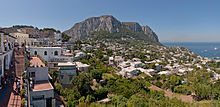

Capri is a tourist destination for both Italians and foreigners. In the 1950s, Capri became a popular resort. In summer, the island is heavily visited by tourists, especially by day trippers from Naples and Sorrento.[23]Many of these visitors make it a point to wear theCapri pantsnamed after the island. The center of Capri is thePiazza Umberto I.[3]
Capri is home to the Mediterranean bush, the Arboreal Euphorbia, and theIlexWood. The native fauna on the island include quails, robins, peregrine falcons, woodcocks, blackbirds, geckos, red goldfish, conger eels, sargos, groupers, mullets, and the blue lizard of the Faraglioni.[citation needed]
Capri has twelve churches, seven museums and several monuments. The most visited attraction in Capri is theGrotta Azzurra('Blue Grotto'), a cave discovered in the 19th century by foreign tourists. On one side of the grotto are the remains of ancient Roman rock, with a narrow cavern.[22]As of 2018 there were plans to limit access to day tourists.[24]
The international luxury linen clothing brand 100% Capri opened its first boutique in the main town of Capri in 2000.[25]
Transport
[edit]
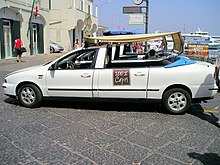
Capri is served byferryorhydrofoilfromNaples,Sorrento,PositanoandAmalfias well as by boat services from the ports of the Bay of Naples and the Sorrentine Peninsula. Boats arrive in the morning and leave after lunch (3–4 pm).[5]Naples is served by two ports: Mergellina and Molo Beverello. Molo Beverello has more frequent departures and a larger selection of boats than Mergellina.[citation needed]
The ferry companies operating routes to Capri are SNAV, NLG, Positano Jet, Alilauro, Captain Morgan and Caremar in 2023.[26]
From Naples, the ferry takes 80 minutes, and the hydrofoil 40 minutes. From Sorrento, the ferry takes about 40 minutes while the hydrofoil takes about 20 minutes.[citation needed]
Boats call at Marina Grande, from where theCapri funiculargoes up to Capri town. From Anacapri, a chair lift takes passengers toMonte Solaro,the highest point on the island. There is also a bus service that connects the centre of Capri town with Marina Grande, Marina Piccola, Anacapri and other points.[citation needed]
Airports
[edit]The nearest airports are:
- Napoli-Capodichino(NAP)
- Salerno-Pontecagnano(QSR)
Twin towns – sister cities
[edit]Capri istwinnedwith:
See also
[edit]References
[edit]- ^ab"capri | Etymology, origin and meaning of the name capri by etymonline".etymonline.Archivedfrom the original on 2022-05-05.Retrieved2023-09-21.
- ^Strabo's Geography,5, 4, 9, 38
- ^abcGellhorn, Martha. "Everybody's Happy on Capri". Saturday Evening Post.
- ^Suetonius.The Lives of the Twelve Caesars. Augustus.LXXII.Retrieved19 February2021.
- ^abFiori, Pamela. "Italy's Pleasure Island Capri". Town & Country.
- ^Geography,5, 4, 9, 38
- ^Konrad Eubel,Hierarchia Catholica Medii Aevi,vol. 1Archived2019-07-09 at theWayback Machine,p. 164;vol. 2Archived2018-10-04 at theWayback Machine,p. 117;vol. 3,p. 151;vol. 4Archived2018-10-04 at theWayback Machine,p. 133;vol. 5,p. 140;vol. 6,p. 146
- ^BollaDe utiliori,inBullarii romani continuatio,Tomo XV, Romae 1853, pp. 56–61
- ^Annuario Pontificio 2013(Libreria Editrice Vaticana 2013ISBN978-88-209-9070-1), p. 858
- ^Selina Shirley Hastings:The Secret Lives of Somerset Maugham: A Biography,Random House Pub, 2009
- ^"Storia gay – Friedrich Alfred Krupp (1854–1902), l'omosessualità e lo scandalo di Capri".giovannidallorto.
- ^Frankel, Nicholas (2017).Oscar Wilde: the unrepentant years.Cambridge, Massachusetts. p. 166.ISBN978-0674737945.
{{cite book}}:CS1 maint: location missing publisher (link) - ^Woods, Gregory (2016).Homintern: how gay culture liberated the modern world.New Haven, Connecticut.p. 220.ISBN978-0300218039.
{{cite book}}:CS1 maint: location missing publisher (link) - ^Swallow, Nicky.Amalfi Coast with Naples, Capri & Pompeii.Hoboken: John Wiley & Sons Inc. p. 265.
- ^"Capri Island APP, Personalities, Romaine Brooks".Archived fromthe originalon 2012-01-13.
- ^Hazzard, Shirley (2000).Greene on Capri.New York: Farrar, Straus and Giroux. p. 4.
- ^ab"World Meteorological Organization Climate Normals for 1991-2020: Capri-16294"(CSV)(Excel).National Oceanic and Atmosoheric Administration.Retrieved27 February2024.
{{cite web}}:CS1 maint: postscript (link) - ^"Capri Art 2011 – Festival della diversità".Capriartfilmfestival. 29 April 2011. Archived fromthe originalon 19 November 2015.Retrieved2 June2011.
- ^abc"Capri Tourism".Capri Tourism.Retrieved2 June2011.
- ^ab"Events".Travelplan.Retrieved2 June2011.
- ^"Going Through Italy (website), accessed 9 January 2012".Archived fromthe originalon 27 May 2011.Retrieved9 January2012.
- ^abcdefgCapritourism,Azienda Autonoma Cura Suggiorno e Tourismo Isola di Capri
- ^Swallow, Nicky (2012).Amalfi Coast with Naples, Capri & Pompeii.Hoboken: John Wiley & Sons Inc.
- ^Sendlhofer, Thomas (13 May 2018)."Zu viele Touristen: Hallstatt zieht Notbremse".Kurier(in German).Retrieved2020-01-13.
- ^Gafurova, Olga (25 November 2018)."100% Capri opens its flagship boutique in Middle East at Dubai Mall Fashion Avenue".AviaMost.Retrieved11 March2020.
- ^[1]
External links
[edit]- Official Capri Tour GuideArchived2021-11-30 at theWayback Machine
- TourItaly.org: CapriArchived2017-07-27 at theWayback Machine
- Capri Insider Tips—by the locals.
- Capri
- Capri 360 panoramasArchived2007-12-30 at theWayback Machine(in French)
- IIalyheaven.co.uk: Capri
- Capri Island APP, a complete guide to Capri on iPad
- Photo Gallery by Leonardo Bellotti(in Italian)
- Capri Life
- James Money (Capri) ArchiveatUniversity College London

